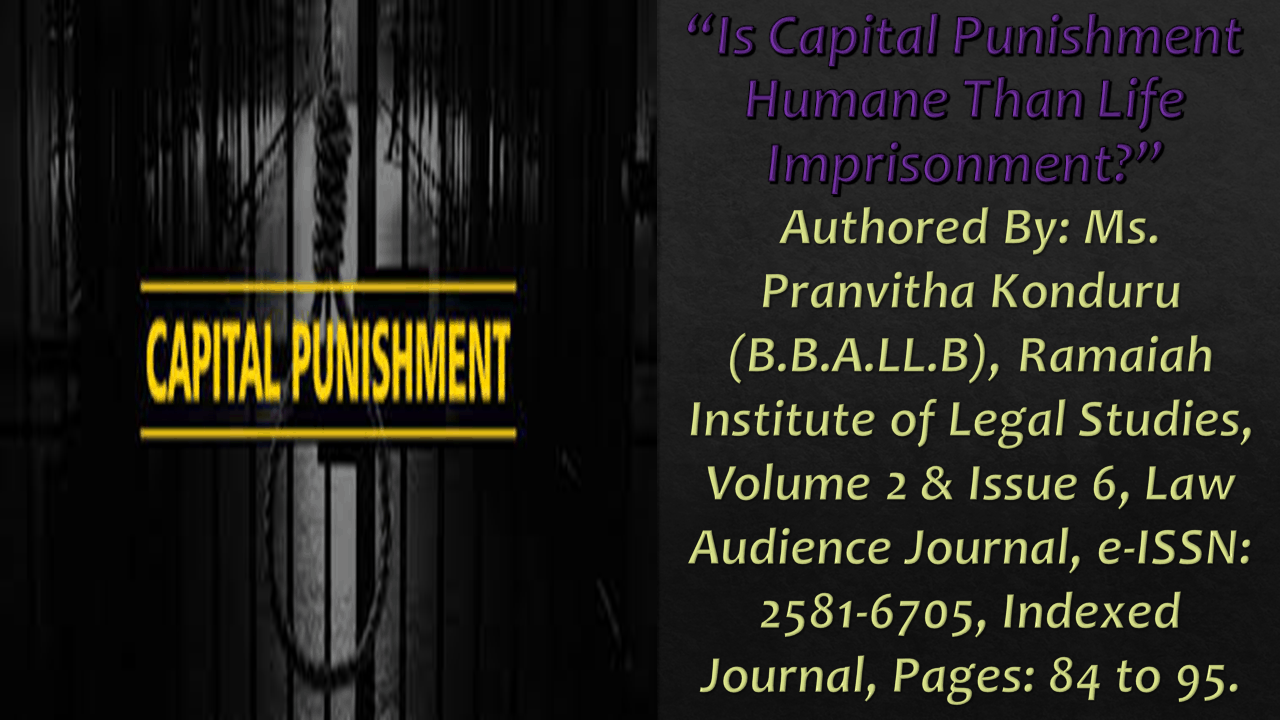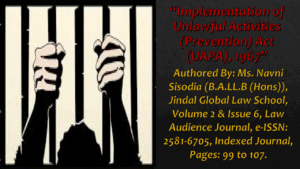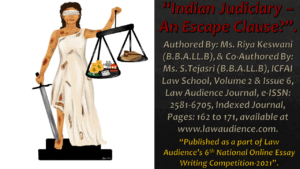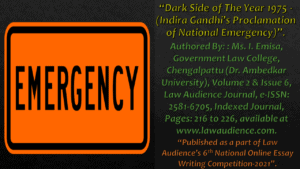Click here to download the full paper (PDF)
Authored By: Ms. Pranvitha Konduru (B.B.A.LL.B), Ramaiah Institute of Legal Studies,
Click here for Copyright Policy.
ABSTRACT:
“This article outlines the problem if the death penalty will be abolished or not and if it is inhumane than life imprisonment. This article will look at Capital Punishment as it applies to cost, deterrence and innocence of the accused. It will discuss these issues as it applies to the overall benefit of abolishing the death penalty altogether. It would also discuss the dreadful nature of capital punishment which makes us lean towards life imprisonment. It would also explain the factors which help to understand that life imprisonment is more humane than a death sentence. The arguments made in this article for death penalty abolition tell how it devaluates human life. All the arguments highlight the facts that human life cannot be taken from a person though if he is a murderer, simply because the society is not being better than the murderer. I have investigated and made a lot of research in the best possible way to strengthen my arguments. I have also stated alternative ways to execute death sentences in a country such as lethal injection which was even supported by the Law Commission of India[1]. In the conclusion, I have stated my reasons about how life imprisonment is more humane than capital punishment.”
I. INTRODUCTION:
An offence is an act which is punishable under the Indian Penal Code. It can also be told as the acts that are illegal under the law can be called as offences. They can be differentiated as violent or non-violent crimes. Non-violent crimes are those crimes that do not involve the use of any force against another person. They involve property crimes like damage to property or theft. They also involve various violations of ordinances and rules, acts of misconduct. Violent crimes can also be called violent criminal offences. It involves force or injury to the body of another person. In these cases, the seriousness of the crime is determined by the degree of physical harm caused to the victim. Both violent and non-violent crimes can result in serious criminal consequences. Violent crimes usually involve severe penalties. Non-violence crimes are punishable by some fine or short jail sentence. These may increase with the severity of the crimes. This will again vary depending on the crime involved and the circumstances[2]. Defences may be available for both violent and non-violent crimes, but still depends on the facts of the case. According to the theories under capital punishment[3], an accused is punished based on the goals, they are retribution, reformation and deterrence. Retribution is the punishment given for an action or for the offence committed by a person. Reformation means to change the criminal character of that person so that he doesn’t commit any offences further. It is an obligation to the society to change a convicted person and give a better opportunity of living. Deterrence is discouraging persons to commit an offence by providing punishment and this is done by creating fear in the minds of the persons. Indian Penal Code explains different punishments that courts may award to a person convicted for a crime [4]. They are, death penalty, imprisonment for life, imprisonment of either rigorous or simple, forfeiture, fine.
II. LIFE IMPRISONMENT:
When an accused is convicted of life imprisonment then he will have to stay in jail till death. That is jail for life or prison for an entire life. If life imprisonment is given to any accused, that means he will be punished in jail till he dies. The Supreme Court held that life imprisonment means imprisonment for the natural life of the prisoner. It is uncertain. It is not for 14 or 20 years[5]. Black law’s dictionary defines imprisonment as “an act confining a person, especially in a prison. It is the discipline that must be exercised over human beings in close confinement which can never be wholly agreeable to those subject to it”[6].
Life imprisonment is awarded to an accused that has been proved guilty of committing grave crimes under Indian Penal Code, 1860 such as murder punishable under section 302, abetting mutiny punishable under section 131, 132, sedition under 124A, criminal conspiracy punishable under section 120B of IPC. Such offences are usually punishable with life imprisonment. The two-judge bench of Supreme Court expressed their opinion about life imprisonment as “ A convict undergoing life imprisonment is expected to stay in custody till the end of his life, subject to any remission granted by appropriate government”[7]. Section 433 of Criminal Procedure Code mandated life imprisonment cannot be less than fourteen years. So the smallest possible period that can be served under life imprisonment is fourteen years.
State of Uttar Pradesh vs. MK Anthony[8]:
The facts of the case are that MK Anthony lived with his 2 children and his wife. He was poor. Unfortunately, his wife started suffering from an incurable disease. He could not afford the medical expenses of the woman, he started watching the sufferings of the woman. Finally, he decides to put an end to the agony. He killed his wife and both the children. In this case, the court had given life imprisonment.
So by this, we can understand that Convict undergoing life imprisonment is expected to stay in custody until the end of his life.
III. CAPITAL PUNISHMENT:
Capital punishment is also called as Death Penalty or execution. It is the execution of an offender sentenced to death after conviction by a court of law. Sometimes death sentence is used interchangeably with capital punishment though imposition of penalty is not always followed by execution. Head is also called as head so the death sentence can be interchanged with capital punishment. Indian Penal Code mentions the definition and punishment. According to the IPC, article 53 death sentence can be given in the rarest of rare cases[9]. Different countries in the world practice different kinds of death sentences. For example,
Death By Swords[10]:
It delivers death sentences through swords. The head of the offender shall be separated by a slash of sword. Execution in Saudi Arabia is usually carried out with a sword. A public beheading will take place around 9 a.m. The convicted person is made to walk to the courthouse and is asked to kneel in front of the person who carries out the execution. The executioner removes the convicted person’s head using a sword called sulthan. This takes place after announcing the crimes committed by the convicted person by the police officer. Then the medical examiner examines the body and he pronounces the death. After which the crimes committed by him are once again announced and the process is declared to be completed. This is commonly practiced in Saudi Arabia as this method is the most easiest and quickest form of execution and it is also mentioned by Sharia law. The Saudi Arabian judiciary mentions three kinds of criminal offence in Sharia law for which the death penalty is imposed. They are Hudud, Quisas, Tazar.
Death By Stoning[11]:
The offender will be placed surrounded by the common public supplied with the stones for pelting on the offender. It is a time-consuming, painful death to the offender. It is also called lapidation. It’s adoption has caused controversy in recent years. It was the standard method of death sentence in ancient Israel. It has been practiced only during the early Christian era, later Jewish courts have not practiced this method for execution. In modern history there are only a few cases that have been recorded where the stoning has been carried out for the purpose of execution. In recent years, several countries have added this method into their respective penal codes because of several Islamist movements. Few countries where stoning has been a legal punishment in Nigeria, Afghanistan, Sudan, Somalia. In Afghanistan and Iraq this method is not legal but it has been carried out by tribal leaders, militants etc. There is varying levels of public support for the purpose of carrying out capital punishment by stoning i.e. 86% of muslims in Pakistan to 6% of muslims in Bosnia.
Death By Firing[12]:
Offenders will be compelled to face a group of soldiers or policemen with loaded guns. They fire at a time on the offenders. It is also called fusillading. This method is practiced in about 70 nations. This method is particularly common in military personnel and in times of war. It is considered as an honourable death which is carried out by the firing squad. The firing squad consists of the military personnel. All the members in the squad are ordered to shoot simultaneously where the convicted person is blind folded. This execution is carried out either when the convicted person is sitting or standing. There is a tradition that the executions must either be carried out at first light or sunrise by which the shot at dawn phrase came into the picture. This method has been reinstated after the Cuban Revolution. The Cuba Constitution has banned capital punishment for peacetime offences and this method is not commonly practiced now. The last executions were carried out in 2003.
Death By Electric Chair[13]:
This method is called electrocution. In modern civilization of science and technology, death can be given to the offenders through an electric chair. This method has originated in the United States. In this method, the convicted person is strapped to a wooden chair which is specially built and electrocuted by electrodes fastened on hands and legs. This method was first carried out in 1890 and it is an alternative method to hanging. In this method of execution the condemned person is made to sit on the chair then the altering current would be passed through the body and they would change the duration and voltage of the current to cause internal damage of the organs. The use of this method is declining because of the rise of lethal injection which is considered as a more humane method of execution. Electrocution has been considered as a secondary method of execution which may be chosen over lethal injection. This method is carried out in Oklahoma, Mississippi. Nebraska Supreme court declared the method of execution by lethal injection as a cruel and unusual method in the year 2008.
Death by lethal injection[14]:
Poisonous chemicals will be painlessly introduced into the veins of the offenders for a few minutes. The offender will go to deep sleep and suffer painless death in a few minutes. The criminologists support the death sentence by lethal injection. The United States was the first country to legalize and implement this. The Law Commission report says that since 1976 many prisoners have been executed in America by lethal injection, 66 executions were carried out in 2001, 586 out of 749 executions were carried out by lethal injection only and even China has experimented with lethal injection. This report also states that this method has been considered for the first time when Bleyer put his idea forward in an article suggesting that morphine should be used for execution of death sentences.
An article on lethal injection[15] states the following.
This method has been adopted for the first time in Oklahoma in the US in 1977 and Texas introduced lethal injection which replaced execution by electrocution. The reason for the adoption is that this method is cheaper and humane when compared to the other methods of execution. This article also states that this method is carried out by the US federal government and military. In this country lethal injection is the sole method of execution. In the beginning of the 21st century lethal injection consisted of three different chemicals which induce unconsciousness, paralyzes all the muscles, by which it causes suffocation and induces cardiac arrest. This entire process takes about 5 minutes. In 2004 and 2006 the US Supreme Court ruled on constitutionality of procedures of lethal injection under cruel and unusual punishments according to the 8th amendment.
Death By Hanging:
In India the law follows death punishment by hanging inside the prison according to the rules and regulations of the jail authorities[16]. This method is a part of Roman Law. The validity of the death sentence depends on the facts. Death sentences will be given validity only in the rarest of rare cases. An article[17] on the death sentence states that hanging and shooting are the methods of execution which are carried out in India. According to a study by National Law University in Delhi, 755 people have been hanged in India[18]. Supreme court in its judgment in a case[19] has held that death penalty is not a mandatory punishment and held that mandatory death penalty is unconstitutional.
Section 416 of CrPC states that if a woman who is sentenced to death is pregnant, then the high court shall order for postponing the execution and if the court thinks fit then it may commute to imprisonment for life and when a person is sentenced to death then he shall be hanged by the neck till he is dead but they shall not state the time nor place where it was carried out[20]. Since Singapore was a British colony, it had adopted the capital punishment and before United Kingdom abolished capital punishment, it became independent. Singapore amended its laws to exempt a few cases from mandatory death sentences.
An article[21] on death sentence executed by hanging has mentioned that it is also called as murder by breaking the neck by a suspended noose. In this method the convicted persons are made to stand on a trapdoor and when it is released they fall several feet until the rope tied around their neck stops. This makes the cervical vertebrae which causes immediate loss of consciousness. This paper also states that this method has been derived by Anglo Saxons from their ancestors who were germanic. Until the abolition of capital punishment in Britain in 1965, it had become the prescribed mode of punishment in England. Until 1868 public hangings were held, later they were moved to prisons.
III.I IMPACT OF CAPITAL PUNISHMENT:
Law treats the death sentence as deadly when compared to life imprisonment. Court decided in Bachan Singh vs. State of Punjab[22], the death sentence will be awarded only in the rarest of rare cases. The Supreme Court held that Life Imprisonment is a rule to which the Death Sentence is an exception. Let’s see the impact of the death sentence.
Capital Punishment Makes Us Less Safe:
There is no evidence that the death penalty deters murder any more than the threat of other punishments such as life in prison[23]. In this study they have mentioned that many criminologists believe that the death penalty makes us less safe, because it needlessly takes away limited resources from policies that have been proven to cut crime. If death penalty actually deterred crime, states with death penalty would be safer than those without, but the opposite is true. States with the most execution have the highest rate of murder. Moreover, murder rate has fallen in New Mexico, New York etc after they repealed the death penalty. In US, all the deterrence studies found that there was no credible evidence that the death penalty deters murders[24].
Capital Punishment Costs More Than A Life Sentence[25]:
It seems like it’s cheaper to execute someone than to feed and take care of them for the rest of their life. But there are a lot of unavoidable costs that make the death sentence more expensive. Death penalty costs million more than one in which prosecutors seek life without parole.
Delays In Executing Death Sentence:
When it comes to the victim’s families, family members who have lost their loved one’s to murder feel that the death sentence will not heal their wounds. The appeal process in death penalty cases results in court hearings for decades with no certainty that the sentence will be carried out. Latest data also show that in India, trial delays make the death sentence ineffective and result in waits for both the families. There were 371 prisoners on death row in India by end December 2017 with the oldest case from 1991, 27 years ago[26]. There has been a study[27] on the victim family that compared the impact of a death sentence with life imprisonment of a murderer. The study found that higher levels of physical, psychological, behavioral health for the families, and more satisfaction with criminal justice, when the accused was given life imprisonment and not death sentence. Delay in death sentence should be a reasonable cause enough to be considered for reducing the sentence from death to life imprisonment keeping in mind the mental agony inflicted on the accused during the tenure.
In The Cases Where The Accused Is Wrongly Convicted:
If the prisoner is able to prove that they were wrongfully convicted in the court of law that they are innocent then the conviction should be overturned and the prisoner should be set free. The only difference between death sentence and life imprisonment is that with a life imprisonment there is no risk if a prisoner being found innocent after they have been executed. But in death sentence, if it is executed and later if he is proved guilty then that cannot be overturned.
Execution of An Innocent Person:
Since the 1970’s, 161 people have been exonerated from death rows around the US. It’s actually hard to prove wrongful executions. A 2012 report[28] gives details about a case in the US where the wrong defendant was executed, the defendant who was executed in fact did not commit the crime. Currently 58 countries actively practice capital punishment, 96 countries have abolished it. The Charter of fundamental Rights of the European Union prohibits the use of capital punishment[29]. Over 60 percent of the world’s population lives in the countries where executions take place like India and China. These nations voted against the UN resolutions about abolition of capital punishment.
Problems Of Death Penalty:
In India, the death penalty is error ridden. From 2000 to 2015, the Supreme Court imposed 60 death sentences and it admitted that it erred in 15 of them[30]. Can this system be trusted?
III.II CAPITAL PUNISHMENT IN TODAY’S WORLD:
The supreme court has observed that the suffering and physical pain which the death sentence entail is no less cruel and inhuman. Law commission report[31] recommended that section 354(5)[32] of the Cr.P.C., be amended by providing an alternative mode of execution of death sentence. These few reasons give us an idea how cruel the death sentence is when compared to life imprisonment. According to an article in the newspaper[33], it states that the death penalty as a punishment makes no sense. It stated “how does killing a person who has killed a person show that killing is wrong?” India certainly doesn’t need it at all because it serves no purpose. No study shows that death penalty deters murder more than life imprisonment.
At the time of Mauryan dynasty, the rule followed to punish a person was an eye for an eye, a hand for a hand. At the later times they followed different punishments like cutting of head, dragging the body by a horse. The criminal laws regarding death penalty were first codified by King Hammurabi who is the king of Babylon. But the question is, in the present era with codified laws and awakened conscience, is death penalty the best option. It is still being carried out in different countries despite many organisations protesting to abolish the death sentence. The UN Charter declared Death penalty as a crime and asked it’s member countries to abolish it. It also declared that the death sentence is against humanity. India is among those countries where the death sentence is still being carried out. The Constitution of India states that the government has no rights to take away the ‘right to life’ given by the constitution[34]. But India on the Moratorium on death penalty both at General Assembly and at Human rights Council has always defended saying that, death sentence in India is only carried out in the “rarest of the rare cases”[35].
The study shows that these conditions have been variously violated over 16 years in the lower courts of Delhi and Maharashtra, which have often imposed the death sentence.
According to Justice Krishna Iyer, a former judge of the Supreme court was himself against the death sentence. According to him, “life is given by god and can be taken away by god himself. The state doesn’t have the right to take away a person’s life. Execution by states amounts to inhumanity. Even if supported by a judicial decision, the state must not hang a person.[36]”
- Prisoners on death row in India are living in inhumane conditions, facing unfair trials according to the study released by a project[37] at National Law University in Delhi. It offers a harrowing insight into unbearable uncertainty the prisoners face and the horrific conditions they have to live in as they wait for judges to decide their fate.
- There is no sufficient evidence to prove that the death penalty is effective in reducing crime than life imprisonment, Brutal rapes in India have not decreased despite the enforcement of the Criminal Law Act[38], 2013 which imposes death penalty for sexual assaults that result in the victim dead.
- It gives arbitrary powers to the government for taking a human life which violates Article 21 of the constitution i.e., Right to life.
- Human rights activist argue that it is inhumane and barbaric to sentence the criminals with capital punishment.
- Death penalty is murdering criminals as revenge. It makes the government as well as citizens murderers.
- Death sentence violates International Human Rights laws.
Protections against the death sentence under the constitution are Article 21, article 72, article 134[39].
IV. CONCLUSION:
As the paper already mentioned ‘an accused is punished based on the objections’, they are retribution, reformation, deterrence. So now when we consider these factors in relation to the Capital punishment, it completely throws away the second objective, because it kills off the accused and not bringing a change in him. As already stated no reports prove that capital punishment helps in deterrence of crimes. Despite these, there are few reasons and factors which strongly support for abolishing capital punishment.
On the other hand, life imprisonment provides another chance to the accused where he might realize his mistake and understand the value of life. Moreover when we look at the other view, killing an accused in a few seconds doesn’t let him know the pain of the victim’s families.
Life imprisonment avoids all these negative impacts and the accused might understand the pain by giving solitary confinement or many other ways and this might bring a change in the mindset of the accused that helps in the betterment of the societies. All these factors help us understand that capital punishment is not humane than life imprisonment.
Footnotes:
[1] Page no. 2, 187th Report on Mode of Execution of Death Sentence and Incidental Matters, Law Commission of India, available at https://lawcommissionofindia.nic.in/reports/187th%20report.pdf.
[2] Jose Rivera, Non-Violent vs. Violent Crimes, available at https://www.legalmatch.com/law-library/article/non-violent-vs-violent-crimes.html.
[3] Under Criminal Law.
[4] Section 53 of Indian Penal Code.
[5] Zahid hussain v State of West Bengal, (2001) 3 S.C.C. 750 (India).
[6] Page no. 889, Imprisonment, Black’s Law Dictionary, available at https://www.latestlaws.com/wp-content/uploads/2015/04/Blacks-Law-Dictionery.pdf.
[7] As held in State of Haryana v. Mahender Singh, (2007) 13SCC 606 and State of Haryana v. Jagdish, (2010) 4 SCC216.
[8] AIR 1985 SC 48, 1985 CriLJ 493, 1984 (2) SCALE 728, (1985) 1 SCC 505.
[9] bachan singh vs state of punjab, (1983) 1 S.C.R.145 (India).
[10] Capital Punishment in Saudi Arabia executed according to Saudi Arabia Penal Code.
[11] In recent times, stoning has been legal in the United Arab Emirates, Yemen and they execute death sentences according to the UAE, Yemeni Penal Code.
[12] Cuba, as part of its Penal system, still utilizes death by firing squad according to Cuban Penal system.
[13] Electric chair has been a symbol of death penalty in United States according to American Penal system.
[14] The 187th Law Commission report in India suggested an alternative mode of execution of death sentences by lethal injection.
[15] Deborah W. Denno, Lethal injection, ENCYCLOPEDIA BRITANNICA ,(Sept. 11, 2013) ,https://www.britannica.com/topic/lethal-injection.
[16] According to 354(5) of CrPC.
[17] Taran Deol, Rarest of the rare, THE PRINT, (March 19, 2020, 7:47 PM), https://theprint.in/theprint-essential/rarest-of-rare-history-of-death-penalty-in-india-and-crimes-that-call-for-hanging/383658/.
[18] Taran Deol, ‘Rarest of rare’ — history of death penalty in India and crimes that call for hanging, available at https://theprint.in/theprint-essential/rarest-of-rare-history-of-death-penalty-in-india-and-crimes-that-call-for-hanging/383658/.
[19] Mithu vs State of Punjab, A.I.R. 1983 S.C. 690 (India).
[20] Under 316 of the Criminal Procedure Code of Singapore.
[21] Britannica, The Editors of Encyclopaedia. Hanging, ENCYCLOPEDIA BRITANNICA, (Dec. 23, 2020), https://www.britannica.com/topic/hanging. Accessed 23 April 2021.
[22] AIR 1980 SC 898, 1980 CriLJ 636, 1982 (1) SCALE 713, (1980) 2 SCC 684, 1983 1 SCR 145.
[23] Study published in North Western University School of Law’s Journal of criminology.
[24] According to the National Research Council Review.
[25] According to the Fox newschannel in the US published on March 27, 2010.
[26] According to the Death Penalty in India report in Jan 2018.
[27] Name of the study – Assessing the impact of ultimate penal sanction on homicide survivors.
[28] “ The wrong Carlos “.
[29] Article 2 of the Charter.
[30] Avi Singh, Yug Mohit Chaudhry, Meenakshi Lekhi, Is it time to abolish the death penalty?, available at https://www.thehindu.com/opinion/op-ed/is-it-time-to-abolish-the-death-penalty/article25735508.ece.
[31] 187th report on Mode of Execution of Death Sentence.
[32] “ When the conviction is for an offence punishable with imprisonment for a term of one year or more, but the court imposes a sentence of imprisonment for a term of less than three months, it shall record its reasons for awarding such sentence,unless the sentence is one of the imprisonments till the rising of the court.”
[33] Yug mohith, Is it the time to abolish death penalty, THE HINDU, Dec 14, 2018.
[34] INDIAN CONST . art. 21.
[35] Srishti Chawla, Critical Analysis Of Death Penalty In India, available at https://blog.ipleaders.in/death-penalty/.
[36] V. R. Krishna Iyer, Terror and horror of the death sentence, available at https://www.thehindu.com/news/national/terror-and-horror-of-the-death-sentence/article4422870.ece.
[37] Death Penalty Research Project.
[38]The Criminal Law (Amendment) Act, 2013, No. 13, Acts of Parliament, 2013 (India).
[39] Article 21 provides right to life for citizens and gives them protection not only against executive actions but also against the legislations. Article 72 gives power to the President to grant pardons and suspend the sentences in certain cases. Article 134 gives the right to appeal the high court verdict in the Supreme Court in any case where the capital punishment was imposed in the reversal of acquittal order.
Cite this article as:
Ms. Pranvitha Konduru, Is Capital Punishment Humane Than Life Imprisonment?, Vol.2, Issue 6, Law Audience Journal, Pages 84 to 95 (2021), available at https://www.lawaudience.com/is-capital-punishment-humane-than-life-imprisonment/.




